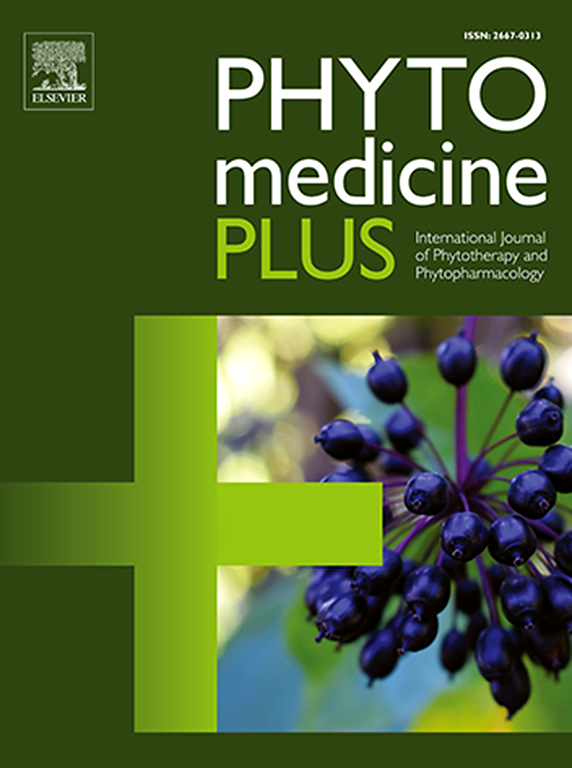非洲花的抗抑郁作用。&穗青葱。小鼠:单胺类神经递质、皮质醇、BDNF和氧化应激的参与
Q3 Pharmacology, Toxicology and Pharmaceutics
引用次数: 0
摘要
非洲entada被用来治疗各种疾病,包括胃痛、白内障、肝病、癫痫和抑郁症。先前的研究报道了其在急性抑郁症模型中的抗抑郁作用。然而,其在慢性模型中的活性及其相关的信号通路尚不清楚。目的探讨非洲叶提取物(EEEA)对慢性抑郁症模型的抗抑郁样作用及其可能的机制。方法采用限药法测定口服致死中位剂量(LD50)。为了确定单胺类神经递质在EEEA抗抑郁作用中的潜在作用,各组小鼠在给药EEEA (4mg /kg)或丙咪嗪(10mg /kg)前30分钟预先给药哌唑嗪(1mg /kg)、赛戊乙胺(3mg /kg)和氟哌啶醇(0.2 mg/kg)。在另一个单独的实验中,动物通过慢性不可预测的轻度应激(CUMS),然后是蔗糖偏好,开放场地(OF)和尾巴悬挂(TS)测试来抑郁。评估皮质醇、脑源性神经营养因子(BDNF)、超氧化物歧化酶和丙二醛的含量。还进行了提取物的植物化学分析。结果小鼠口服LD50约为2000 mg/kg。预先给药哌唑嗪、赛庚啶和氟哌啶醇显著(p <;0.05)减弱了EEEA的抗抑郁作用。在CUMS实验中,EEEA显著(p <;0.05)逆转了体重下降,改善了蔗糖消耗,增加了OF的探索,缩短了静止时间。EEEA显著(p <;0.05)降低血清皮质醇,增加BDNF浓度,改善氧化应激。鉴定出黄酮类、皂苷类、萜类和单宁类。结论非洲野檀在慢性抑郁模型中具有抗抑郁样作用,其机制可能与单胺类NTs、皮质醇、BDNF和氧化应激通路的改变有关。本文章由计算机程序翻译,如有差异,请以英文原文为准。
Antidepressant-like effect of Entada Africana Guill. & Perr. (Fabaceae) in mice: Involvement of monoamine neurotransmitters, cortisol, BDNF, and oxidative stress
Background
Entada Africana is used to treat various disease conditions including stomach ache, cataract, liver disease, epilepsy and depression. Previous research reported its antidepressant properties in acute depression models. However, its activity in chronic model and the associated signaling pathways remain unclear.
Purpose
To elucidate the antidepressant-like effect of ethanol leaf extract of Entada Africana (EEEA) in chronic model of depression and the possible mechanism(s).
Methods
Limit test was utilized in determining the oral median lethal dose (LD50). To establish the potential roles of monoamine neurotransmitters in the antidepressant action of EEEA, groups of mice were pre-administered prazosin (1 mg/kg), cyproheptadine (3 mg/kg), and haloperidol (0.2 mg/kg), 30 min before administering EEEA (4 mg/kg) or imipramine (10 mg/kg). In a separate experiment, animals were depressed via chronic unpredictable mild stress (CUMS), followed by sucrose preference, open field (OF), and tail suspension (TS) tests. The quantities of cortisol, brain-derived neurotrophic factor (BDNF), superoxide dismutase, and malondialdehyde were estimated. Phytochemical profiling of the extract was also conducted.
Results
The oral LD50 was estimated to be >2000 mg/kg in mice. Pre-administration of prazosin, cyproheptadine, and haloperidol significantly (p < 0.05) attenuated the antidepressant action of EEEA. In CUMS experiment, EEEA remarkably (p < 0.05) reversed the weight loss, improved sucrose consumption, increased exploration in OF, and shortened the duration of motionlessness. EEEA significantly (p < 0.05) lowered the serum cortisol, increased BDNF concentration, and ameliorated oxidative stress. Flavonoids, saponins, terpenoids and tannins were identified.
Conclusions
Entada Africana exerted antidepressant-like effect in chronic model of depression, which may be mediated via modifications of monoamine NTs, cortisol, BDNF, and oxidative stress pathways.
求助全文
通过发布文献求助,成功后即可免费获取论文全文。
去求助
来源期刊

Phytomedicine Plus
Medicine-Complementary and Alternative Medicine
CiteScore
3.70
自引率
0.00%
发文量
178
审稿时长
81 days
期刊介绍:
 求助内容:
求助内容: 应助结果提醒方式:
应助结果提醒方式:


